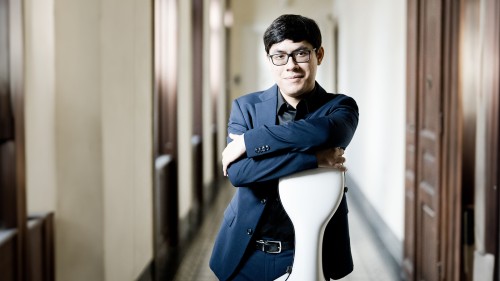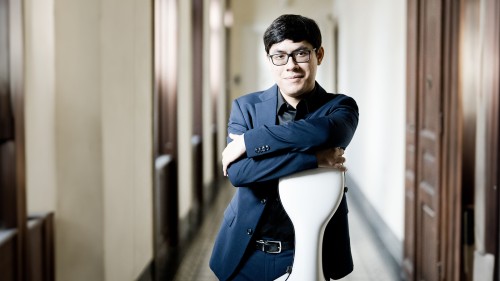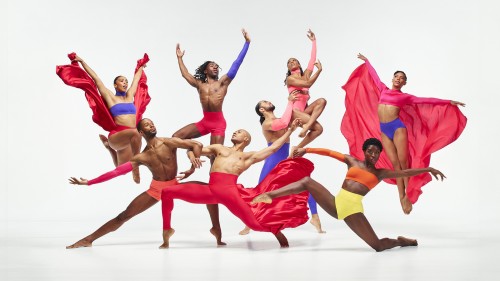
Zlatomir Fung, cello and Chaeyoung Park, piano
in Cambridge, MA
This site uses cookies to measure our traffic and improve your experience. By clicking "OK" you consent to our use of cookies.
Pianist Zlata Chochieva, celebrated by critics and embraced by audiences throughout Europe, returns to the United States for her long-awaited Boston debut.
The program offers a journey through her recording and performance interests, notably highlighting works by Rachmaninoff. Chochieva’s recording of Chopin’s complete Études attracted the world’s attention, with Gramophone listing it among the ten greatest Chopin recordings of all time. Moreover, her recordings of Rachmaninoff’s complete Études-Tableaux and her role as curator for a festival at the composer’s summer villa speak volumes of her deep connection with that composer’s works. Acclaimed for her “performances of huge emotional scope and intense drama” (The Guardian), Zlata Chochieva promises a can’t-miss Celebrity Series debut!
J. S. Bach / Béla Bartók | Organ Sonata No. 6, BWV 530, second movement
Robert Schumann | Symphonic Etudes, Op. 13
Johannes Brahms | Romanze in F Major, Op. 118, no. 5
Johannes Brahms | Scherzo in E-flat minor, Op. 4
Sergei Rachmaninoff | Selected Preludes
Sergei Rachmaninoff | Variations on a Theme of Corelli, Op. 42
Felix Mendelssohn / Rachmaninoff | "Scherzo" from A Midsummer Night’s Dream
Born into a family filled with professional musicians, Johann Sebastian Bach (1685-1750) proved his talents through a series of jobs as a church organist. After six years working in a secular role for a prince, he finally landed his dream job in Leipzig, where he was responsible for preparing music for the city’s main churches and training the young choristers who would perform it.
Even with his staggering workload, Bach still found time for pet projects, including a number of keyboard compositions to prepare his sons to enter the family trade. His second oldest son, Wilhelm Friedemann Bach, showed particular promise as an organist, and it was probably for his benefit that Bach assembled a set of pioneering organ sonatas in the late 1720s. The sonata format reflected the Italian tradition of the trio sonata, which typically involved two violins or other melody instruments accompanied by basso continuo. Bach’s novel concept was to situate all three of those parts on an organ, with the two hands on separate manuals and an independent bass line played on pedals. Most of the six sonatas included some recycled material, but the Organ Sonata No. 6 in G Major (BWV 530) was entirely new, including a haunting Lento that wove long skeins of melody in the related key of E-minor. Béla Bartók (1881-1945), an ardent admirer of Bach, created this piano transcription.
◊ ◊ ◊
In 1830, the 20-year-old Robert Schumann (1810-1856) dropped out of a university law program to pursue music. He was “not a musical genius,” as he acknowledged in his diary, but he pursued his goals doggedly, moving to Leipzig to take piano lessons with the distinguished teacher Friedrich Wieck. He hoped to build a life as a virtuoso composer-performer, but in his efforts Schumann damaged his right middle finger permanently with an overzealous practice regimen and the use of an ill-advised mechanism to strengthen his fingers.
He pivoted to a side career as a music critic while he was working to establish himself as a composer, and in 1834 he proudly launched his own music journal. That was also the year he met a young woman named Ernestine who was taking piano lessons with his old teacher. Their romance eventually fizzled, but the association with Ernestine left an imprint in two major piano works initiated that year: Carnaval and the Symphonic Etudes (Opus 13).
For the Symphonic Etudes, Schumann devised a grandiose set of piano variations on a relatively simple theme that had been sent to him by Ernestine’s father, a baron and amateur flutist who dabbled in composition. The original impetus may have been to flatter his potential father-in-law, but the project continued to occupy Schumann long past the point in 1835 when he broke off his engagement with Ernestine.
As in many of his works from that period, Schumann brought out the divergent aspects of his inner life by channeling two alter-egos: the bold and fiery Florestan, and the dreamy and introspective Eusebius. He wanted to title the original version Studies in Orchestral Style for Piano by Florestan and Eusebius, but his publishers opted for the more neutral title of 12 Orchestral Etudes. Schumann made revisions in 1852, and in its final incarnation, his protégé Brahms prepared a posthumous edition that restored material cut from the original version. Filled with ambitious music created in a formative period, these larger-then-life etudes showcase the fertile imagination of a young man overflowing with passion.
◊ ◊ ◊
Johannes Brahms (1833-1897) announced his retirement in 1890, but he was lured back to composing when friends arranged for him to hear the clarinetist Richard Mühlfeld. The encounter inspired Brahms to break a year’s silence in 1891 with the Clarinet Trio and Clarinet Quintet, and the muse kept her gifts flowing in a series of piano miniatures: Seven Fantasies, Three Intermezzos, Six Piano Pieces (Opus 118), and then another Four Piano Pieces. Brahms claimed retirement again in 1894, and once again he came out of retirement to write two sonatas for Mühlfeld, but no further piano music followed before Brahms’ death in 1897.
Brahms dedicated Opus 118 to Clara Schumann (Robert’s widow), who had been one of his dearest friends for 40 years at that point. He called the fifth piece a Romanze, indicating a simple and tuneful style of slow movement. Outer sections set in a stately pulse with six beats per measure surround a dreamy middle section that glides over a rocking ostinato.
The self-assured Brahms who wrote that placid miniature as one of his last piano works was a world apart from the 18-year-old composer of the Scherzo in E-flat Minor (Opus 4). At 20, when a gig touring with a violinist marked Brahms’ introduction to the professional community beyond his hometown of Hamburg, he used this Scherzo as a calling card. Franz Liszt sight-read it in Weimar, and Brahms brought it next to Düsseldorf, where he made the fateful visit to the Schumann family that changed the course of his life.
◊ ◊ ◊
Sergei Rachmaninoff (1873-1943) graduated from the piano program at the Moscow Conservatory with honors in 1891, and he capped his composition studies the next year by earning a rare “Great Gold Medal” and attracting his first publishing contract. An early Prelude in C-sharp minor became one of his most recognizable calling cards, and everything seemed aligned for Rachmaninoff to take his place as the leading young composer in Russia. Then disaster struck in 1897, when the botched premiere of his First Symphony created such a bad impression that Rachmaninoff resisted composing anything new for three years, and then only resumed after months of work with a hypnotherapist. He finally bounced back on the strength of his Second Piano Concerto from 1901, and he entered a phase of remarkable productivity that balanced the competing demands of composing, conducting, and touring as a piano virtuoso.
Complementing his earlier Prelude, Rachmaninoff composed a set of 10 Preludes (Op. 23) in diverse keys between 1901 and 1903. He then wrote an additional 13 Preludes (Op. 32) in 1910 to complete the cycle of all 24 major and minor keys, includng the original C-sharp minor Prelude (for those counting!). The tradition of keyboard preludes that cycle through the major and minor keys started with Bach and his two books of The Well-Tempered Clavier, in which each prelude served the traditional function of preparing a fugue in the same key. Chopin followed by writing his own preludes in all the keys, but he let each one stand alone without a companion movement, establishing a poetic model for the prelude that Rachmaninoff and many others followed.
Between the geometry of the piano keyboard with its pattern of white and black notes, and the quirks of tuning a piano that makes every interval the slightest bit out of tune in its own way, different keys really do dictate different modes of expression. Within these selections from the Opus 23 and Opus 32 Preludes that show off Rachmaninoff’s emotional range and stunning virtuosity, he seems to especially relish the possibilities of minor keys, from restlessness in C-minor to bewitching lightness in A-minor.
◊ ◊ ◊
Rachmaninoff composed his final score for solo piano, the Variations on a Theme of Corelli (Opus 42), in the summer of 1931. The theme he used, known as “La Folia,” was the Baroque equivalent of a jazz standard, passed among musicians as a vehicle for improvisations since it emerged as a dance tune in fifteenth-century Portugal. The telltale harmonic skeleton of “La Folia” rolls out in the opening phrases, but Rachmaninoff’s variations migrate well beyond these age-old harmonies.
◊ ◊ ◊
Felix Mendelssohn (1809-1847), the son of a banker and the grandson of a famous philosopher, grew up amid extraordinary wealth and a family culture of insatiable curiosity. This was the kind of family that rushed to buy a new German translation of Shakespeare’s collected plays published when the budding composer was 16; a year later, he created one of his first true masterpieces in the concert overture based on A Midsummer Night’s Dream, making reference in the music to the comedy’s magical elements and bawdy humor.
Mendelssohn returned to the same themes seventeen years later when he contributed incidental music for a new production of that Shakespeare comedy. The selections included the earlier Overture, as well as thirteen new sections using chorus, vocal soloists and orchestra. The movements for orchestra alone—the Scherzo, Intermezzo, Nocturne and Wedding March—originally served as entr’actes interspersed among the play’s five acts, with the beguiling Scherzo preparing the first entrance of the fairy Puck at the start of the second act. Mendelssohn himself created transcriptions of those selections for four hands at the piano, but it took a pianist as daring as Rachmaninoff to render the same music with two hands. Considering that Rachmaninoff’s earliest surviving orchestral music is a Scherzo written at 14 in clear imitation of Mendelssohn’s example, his affection for this score clearly ran deep.
© Aaron Grad, 2025
“I can think of few piano recitals finer than this ”
Seen and Heard International
This performance is made possible in part by support from Celebrity Series' LIVE PERFORMANCE! Arts for All Innovation Funds.

in Cambridge, MA

in Groton, MA




Co-sponsored by Ágora Cultural Architects.
Stay in touch with Celebrity Series of Boston and get the latest.
Email Updates Sign up for Email Updates